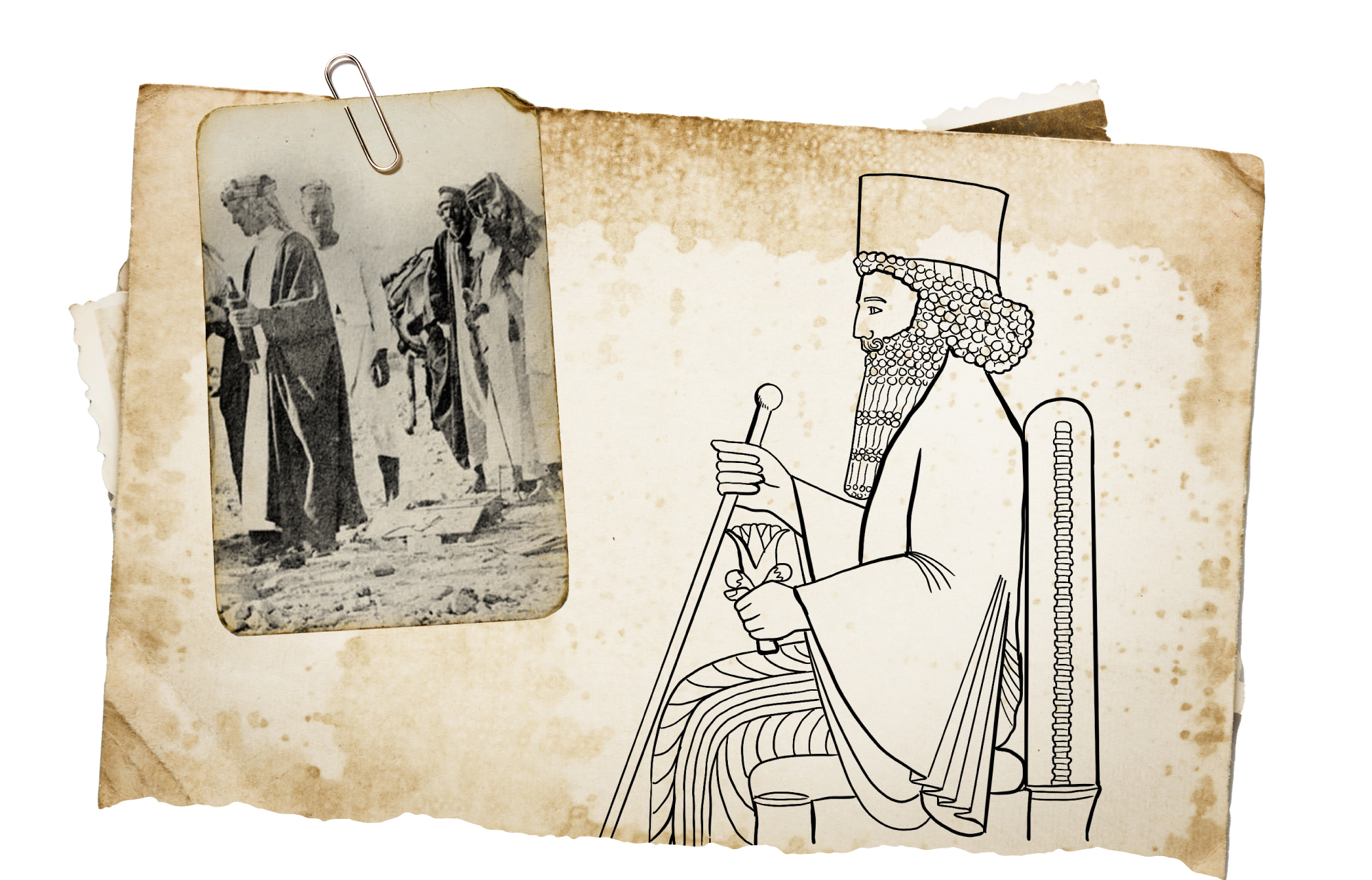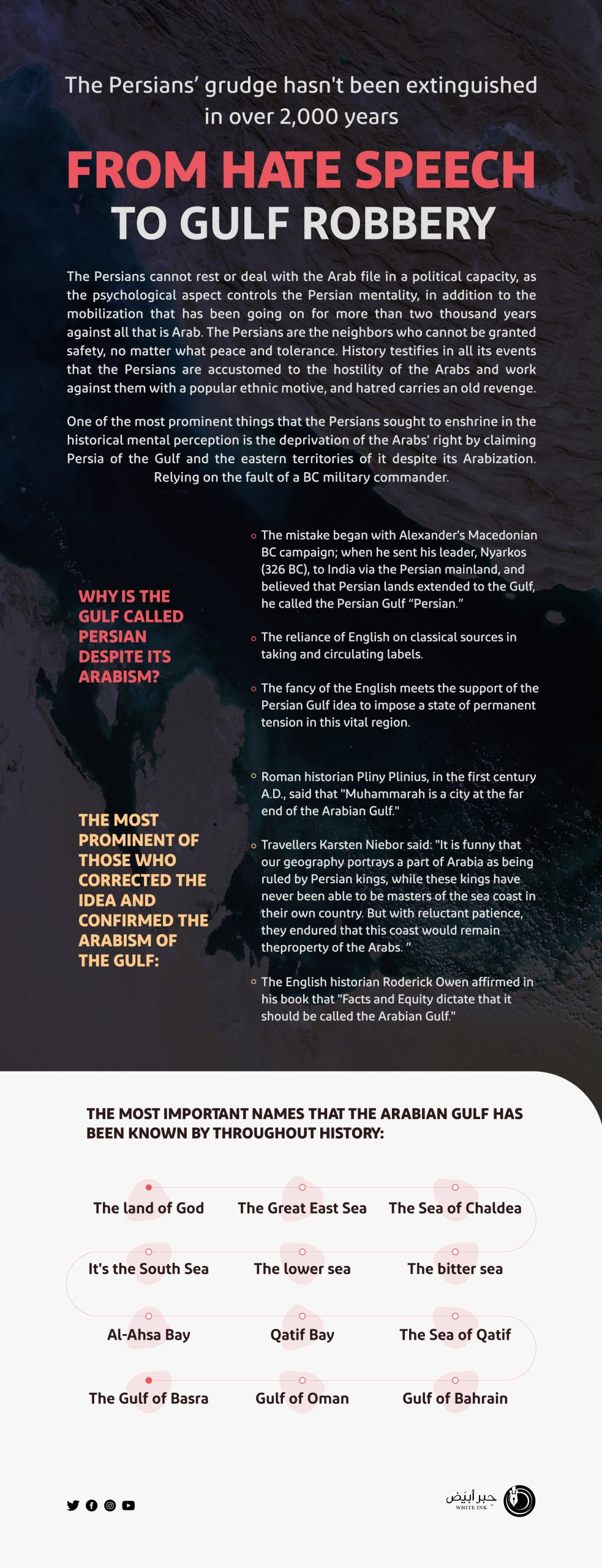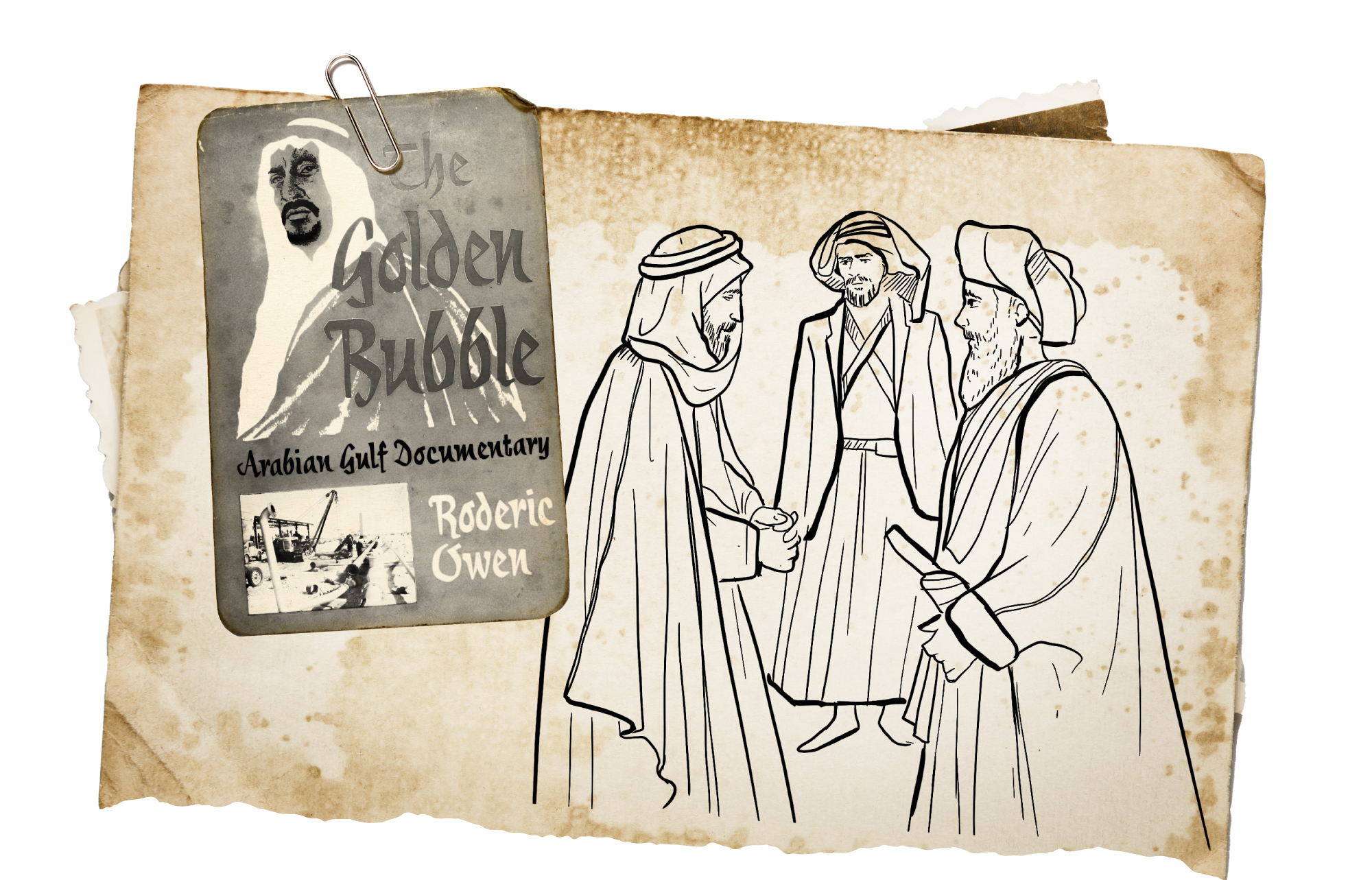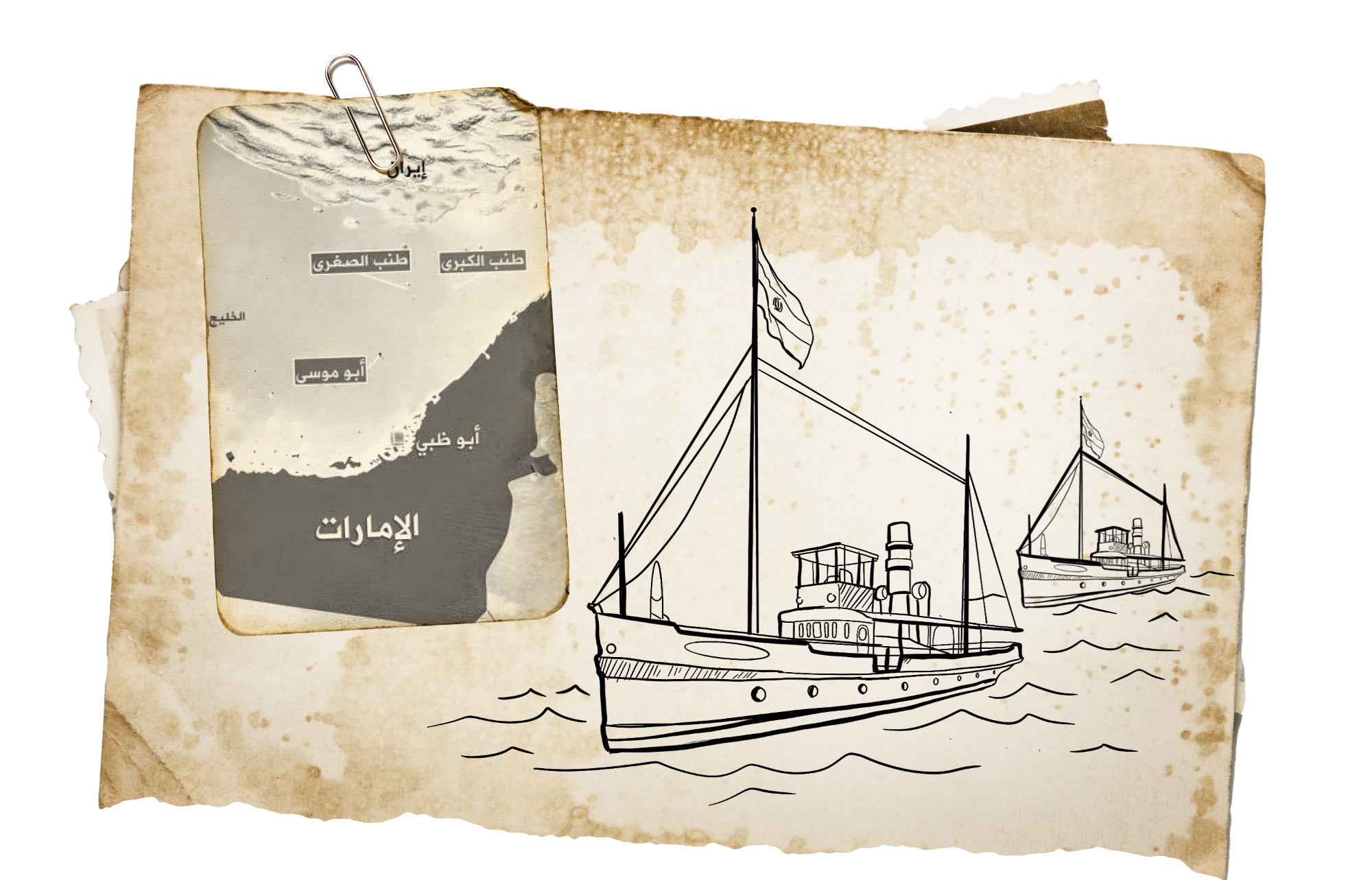
In the First Persian Hate Speech:
Khosrow: “I Saw No Good Characteristic of Arabs”
The mentality of Persian arrogance and hostility against Arabs dominated for a long time, and controlled their mind. They also found that Arabs were uncontrollable rival. Therefore, they based their strategy on the attempt of the subjugating Arabs through direct occupation, agents, or imposing tribute on Arabs to economically exhaust them. This is supported by what was reported by Ibn Al- Atheer with regard to what was done to Kharaj (a type of individual Islamic tax) and soldiers by Khosrow Anushirvan, saying to his assistants: “Force people to pay tribute except for lords, nobles, soldiers, satraps, authors, and servants of the king. Each shall pay the amount he can afford, twelve dirhams, eight dirhams, six dirhams, four dirhams”.
Persians did not deem Arabs as neighbors; they rather deemed them as enemies and inferiors to them. When they were defeated in the two battles of Dhi Qar and Al- Qadisiyah, they went berserk and accused Muslim Arabs of targeting the Persian heritage in the first two centuries after the emergence of Islam and the conquest of Persia, which they called the Era of Silence. This proves that the Persian conscience despises, hates and detests Arabs although the Arab person was the one who brought Islam to the Persians. Otherwise, Persians would have been worshiping fire in the Valley of Persia so far.
The Persian mentality is revealed through an ancient text in which the use of the tribute to control other peoples is explicitly mentioned. The text dates back to the Persian King “Darius”: “I’m Darius the Great- King of the Kings- the King of the lands inhabited by all peoples; the long- standing King of this great land- son of Hystaspes member of Achaemenids– Persian and son of a Persian, Aryan and descendant of Aryans”. He also said, “Thanks to Ahura Mazda, these are the lands, beyond Persia, which I own, and control. They pay tribute to me, do my commands, and obey my law: Media– Susiana- Partia- Hariva– Herat, Bactra (Balkh), Saghd, Khwarazm (Khiva)… India, Babylon, Assyria, Arabian countries, Egypt, Armenia, Cambathokia, and Sparta”. In addition, “when Ahura Mazda saw the lands he entrusted to me- he made me a king, praise be to Ahura Mazda, I have regulated their conditions and my commands are obeyed according to my desire. When I ask myself, how many lands have been ruled by King Darius, I look at this picture: They carry you on the throne, may you know them, you will know that the spears of the men of Ars have gone very far. You will also know that Persians started war far from Persia”.
The Problem of Fear between the Two Banks of the Arabian Gulf
A research published in Adab Al- Kufa Journal traces the development of the Persian- Arabian relations to the time of the Persian “Cyrus”. It described the relations as full of connections, indicating that in 240, Persians established the Emirate of Al- Hira on Euphrates River near Arabs who were the owners of the land of Iraq and the north of the Arabian Peninsula. Many Arab delegations came to the court of the princes of Al- Hira and learned about the Persian culture and transferred it to their countries. There were also close connections between Persians and Arabs in Bahrain, Oman and Yemen.
Thus, the relation between Persians and Arabs is old, dating back to very ancient BC centuries. It was dominated by the problem of the Persian fear of the development and progress of Arabs. The relation ranged between military, cultural and economic, and Persians intended not to make it based on equality and neighborhood, but rather on superiority and an attempt of imposing guardianship and subordination on Arabs; as they were- in their view – inferiors to them; and because the goal of Persia was to impede Arabs and hinder their progress. This became clear in the second Hijri century, after Persians had managed to control and tighten their grip over the Abbasid State, thus, Arabs turned into hostages to Persian myths, deliberately raising the status of the Persian race and underestimating Arabs. For all these reasons, the populism phenomenon, that targeted the Arab element, spread. Perhaps the era of Abbasid disintegration and decadence that followed was on account of that Persian fascism and its crippling impact on the Arab culture and development.
History Does Not Lie
Shaker Majid Al- Shatri, the researcher, confirmed in his book titled Writing the History of the Persian Empire that Sabur was the one who started his first wars against Arabs in Ard Al- Sawad (the Black Land) or Iraq so he destroyed them by killing and torturing. He deliberately harmed them and evicted them from their country, especially the tribe of Iyad. According to this spiteful situation, Sabur managed to eradicate Arabs. He killed many people of the tribes of Iyad and Tamim. His armies launched extermination campaigns, so some of them fled to Romans; some went to the east of the Arabian Peninsula, then, he returned to Diyarbakir and eradicated them too. After that, he went to Al- Yamamah going deeply into the Arabian Peninsula. In case anyone opposed him, he pierced his shoulders; therefore, he was called Dhul- Aktaf (the one who pierces shoulders). In addition, it is said that he crucified them from their shoulders on the mountains.
Persians... If Arabs did not open their homes, they would have remained worshiping fire so far.

Dr. Jawad also said in his book titled Commentary on the History Of the Arabs Before Islam, “People reporting news mentioned that Sabur was called Dhul- Aktaf only because he pierced the shoulders of Arabs”. He did not regard that it was unlikely that Sabur pierced the shoulders of Arabs. Such cruel and painful torture was well known in those days.
In the book titled The Arabs Before Islam- Their Political and Religious Conditions – and the Most Important Aspects of Their Civilization, the author, Mahmoud Arafa Mahmoud, said, “The caravans of Persians passing through the Arabian Peninsula to the Levant, coming from Egypt to China, were the wealth cause of the tribal leaders who worked for their service, comfort and guard until they safely reached their goals. Goods of Persians were sent to Al- Hira guarded by men from Persia, then, Bani Tamim took over this mission inside the island. They continued proceeding until they left its protection circle to another tribe and so on in exchange for a definite wage.”
Arabs in the View of Khosrow
In a dialogue reported by historians between Al- Nu’aman bin Al- Mundhir, the Arab king, and Khosrow, the Persian king described Arabs, saying:, “O Nu’aman, I have thought about Arabs and other nations, and I considered the status of the delegations of nations that come to me, I found that Romans were fortunate due to their coherent unity, great power, multiple cities, and solid structure. It also had a religion that clarified the Halal (lawful) and Haram (forbidden); stopped their fools; and reconditioned their ignorant ones. In addition, I deemed that India had some of that with regard to its wisdom and medicine with its multiple rivers and fruits, as well as its wonderful craft, good trees and large number of people. Likewise, China is similar to them in respect to its unity, many kinds of craftsmanship, horsemanship, diligent work regarding war machines and iron industry. In addition, it had a kingdom gathering its people. As for Arabs, I saw no good characteristic of them neither regarding religion, worldly affairs, firmness, nor strength; although their humiliation, indignity, and discouragement is evident through their status living with repulsive beasts and wavering birds killing their children because of privation, and eating each other due to need. They were the furthest from the delicious food, clothes, drinks, amusement and pleasures of life. The best food that has ever tasted by the sybarite of them was the meat of camels that many wild beasts did not like to eat because of its hard texture, bad taste and the fear of getting a disease. If any Arab hosted a guest, he considered it an honor. Shall he served a meal, he considered it an advantage. It is said in their poems, and boasted by their men. Thus, I do not see you humble to your humiliation, indignity, privation, and misery, you are, rather, proud and desire to have higher ranks than others”.


- Jawad Ali, Commentary on the History of the Arabs before Islam, ed. 4 (Beirut: Dar Al- Saqi, 2001).
- Shaker Al- Shatri, Writing the History of the Ancient Persian Empire (Ta’rikh Al- Empratorya Al- Farisya Al- Kadima) (Baghdad: Al- Ameed library, 2015).
- Abdul- Wahhab Azzam, The links between the Arabs and the Persians and their Etiquette in the Pre- Islamic Era and Islam (Cairo: Hindawi Foundation, 2013).


English historian Rodrick Owen:
Facts and fairness require it to be called “The Arabian Gulf”
The Persians used to treat others from the neighboring peoples with arrogance and haughtiness, especially the Arabs. Iran believes that it has the right to control the Arabian Gulf and considers its western coasts that they were colonies belonging to the Kingdom of Persia before Islam. The Persians also insist on calling it the Persian Gulf, and they falsely claim that this is the only name for the Gulf, even though the inhabitants of the western and eastern coasts of the Gulf are authentic Arab tribes that have been distributed on its banks since ancient times in the form of coastal cities and sea ports. In addition, we can point out that the Arabs control the deserts that overlook it. If we deeply discuss the true name of the Gulf, we will find that the Arabs in the past called it the Gulf of Al-Basra, the Gulf of Oman, the Gulf of Bahrain, the Gulf of Al-Qatif, Al-Qatif Sea and the Gulf of Al-Ahsa, because these places used to take it as a starting point for ships passing through its gates and controlling its waters, and from it they communicate with the world, east and west.
In fact, the Arabian Gulf has been called by many names throughout the ages. The oldest name by which the Gulf was known is “The land of God” three thousand years ago, then it became known as “The Great Sunrise Sea” until the second millennium BC. It was also called the “Chaldean Sea” in the first millennium BC, as the Chaldeans had a kingdom in Mesopotamia. The Assyrians and Babylonians also called it “The southern sea” or “The lower sea”. In some references, it was also called “The Bitter Sea”.
When referring to some ancient classical historical sources, we find that it was called the Persian Gulf at a certain time in history, not because of their right to that name, but because geographers and travelers at that time did not know what was on the western bank of the Gulf. The first person to call it the Sea of Persia was Alexander the Great, after the voyage of Niarchos in 326 BC, who returned from India with his fleet along the eastern coast of the Gulf on the outskirts of Persia, where Alexander was waiting for him, as he did not know anything about the Arab coasts from the Gulf. This is what made Alexander call it the Persian Gulf. The one who changed this name in the first century AD was the Roman historian Pliny the Younger, who said that “Al-Muhammara is a city located at the far end of the Arabian Gulf”.
The Persians and the English insisted on Niarchos' mistake when he called it “The Persian Gulf”.

The name of “The Gulf of Al-Basra” dates back to the period of the Islamic conquest during the era of the Rightly Guided Caliph Umar Ibn Al-Khattab, may God be pleased with him. The early grammarians used it, such as Al-Khalil Ibn Ahmed Al-Farahidi (died 160 AH), as well as the Arab geographers such as Yaqut Al-Hamawi and historians such as Khalifa Ibn Khayat and Imam Al-Dhahabi. The name of the Gulf as the Persian Gulf was also common in the Islamic era, especially among the Persian Muslims, to the extent that some used the two names together. In the Abbasid era, some Arabs called it the Gulf of Iraq, but the name “Arabian Gulf” remained in use, as it remained known since before Islam and continued until after Islam among the inhabitants of the Arabian Peninsula and its surroundings. Iraqi historian Mustafa Jawad talks about the Gulf of Al-Basra and says: “The Gulf is the Gulf of Al-Basra, and some Western historians have called it the Persian Gulf because most of those historians and Western travelers wanted to cross it from the Arab side to the Persian side, not the other way around, and the destination is what determines the name. For example, when you are in Baghdad and you want the road that leads to Al-Basra, you call it Al-Basra road, but if you are in Al-Basra and you want the road that leads to Baghdad, you call it Baghdad road. This was the case with the Gulf when its goal was to cross and reach Al-Basra, so the name was Al-Basra Gulf, which is the upper end of the Gulf. As for those who cross it from the Persian side and want the Arab side, it is Al-Basra Gulf, especially for the general population of Persia, India and the areas of present-day Pakistan. Most of what is narrated about the region is related to pearling, shipbuilding, fleets that pass through the Gulf, ancient and modern, to India, China, Indonesia, the Philippines, Solomon Islands, bringing timber from Java (Jawa), and many more. The populations of India and Pakistan still maintain some relations between them and the people of the Gulf, the region and Al-Basra”.
In the middle of the eighteenth-century AD, the traveler Carsten Niebuhr toured Arabia, passing through the Gulf, and said: “I cannot pass silently on the more important colonies which, though established outside the borders of Arabia, are closer to it. I mean the Arabs inhabiting the southern coast of Persia. They are often allied with the neighboring sheikhs or subject to them. Different circumstances indicate that these tribes settled on the Persian Gulf before the conquests of the Caliphs and have always maintained their independence. It is funny that our geographers make a part of the Arab countries as if it is under the rule of the Persian kings, while these kings were never able to be masters of the sea coast in their own countries, but they endured patiently and reluctantly that this coast remain the property of the Arabs”.
Whoever traces foreign documents, whether British or French, will find that there is a clear colonial competition over the name of the Gulf. The British called it the Gulf of Persia, while the French called it the Arabian Gulf, which is what Iran followed, which had friendly relations, agreements and common interests with the British, and proved what the British colonialists had proven. If the French had the upper hand, they would call it the Arabian Gulf, in line with what those powers wanted. In the twentieth century, some Western researchers began to abandon the Persian name of the Gulf, including the English historian Roderic Owen, who visited the Arabian Gulf and published a book about it in (1957 AD). His book was entitled “The Golden Bubble: Arabian Gulf Documentary”. In it, he narrated that he visited the Arabian Gulf and believed that it was a Persian Gulf because he had only seen this name on the geographical maps, but when he closely saw the Gulf, he was sure that it would be more correct to call it “The Arabian Gulf” because most of the inhabitants of its coasts are Arabs. He said: Facts and fairness require it to be called “The Arabian Gulf”.
In his book Frontiers and Borders, the French writer Michel Foucher sees that the Gulf, which was called the Persian Gulf because of the strong and historical influence of Iran, found support from the American strategy at the time of the Shah based on supporting the Shah and his army to achieve regional security in the protection of oil. The dispute between the Arabs and the Iranians is not just a verbal or nominal dispute, but rather a dispute that reflects a political and national struggle of strategic dimensions for the sake of domination over the Gulf, its waters, islands, oil, strategic locations, security and wealth. In fact, this is in line with Iran’s real desire to dominate the Arabian Gulf by controlling its waters, oil and strategic locations.


- Qadri Kalaji, The Arabian Gulf – a Sea of Legends (Beirut: All Prints Distributors & Publishers, 1992).
- Mahmoud Shaker, Encyclopedia of the History of the Arabian Gulf (Amman: Dar Osama for Publishing and Distribution, 2005).
- Sayed Nofal, The Political Status of the Emirates of the Arabian Gulf and Southern Arabia (Cairo: League of Arab States, 1961).
- Carsten Niebuhr, Niebuhr’s Journey to Arabia, translated by: Munir Arish (Riyadh: King Abdulaziz Public Library).
- Nabil Khalifa, The Arab-Persian Conflict (Byblos Center for Studies, 2018).
- Roderic Owen, The Golden Bubble: Arabian Gulf Documentary (London: Collins, 1957).

The three Emirati islands:
The Persians occupied them with Western complicity
The Persians succeeded in gaining control of four Arab capitals in practice, which indicates that the rulers of Iran continue to use the strategy of subjugating the Arab countries by relying on malicious tactics that have nothing to do with religion and adapt the text to serve a solid ethnic agenda that professionalizes the doctrine to serve the goals of the race.
The Persians were influenced by fanatical nationalism. This made them eager by various means and methods to revive the glory of the ancient Persian Empire. Perhaps what helped the Persians succeed in subjugating some Arab lands is the presence of a third party, either internal or external, colluding against our countries in favor of Iran in return for a set of concessions that Tehran has striven to offer.
There has always been a third party, internal or external, colluding against the Arab countries for the benefit of Iran.

The occupation of the three Emirati islands (Greater Tunb, Lesser Tunb and Abu Musa) constituted a physical embodiment of the Iranian penetration into the Arabian Peninsula, given its important geostrategic location and its mineral capabilities, in addition to being an advanced base for trying to control other countries in the region.
If many of the public consider some small islands not of that strategic and economic importance, this is due to the lack of knowledge of some important details, especially those related to the law of the sea, which gives a set of privileges to countries that exercise their sovereignty (and not their administration) whether on the island or on the territorial waters as well as the continental shelf which may extend to thousands of nautical miles.
The geostrategic importance of the three Emirati islands lies in their extremely important position as strong monitoring points on the coasts of Iraq, Iran and the rest of the Arab Gulf states. They are more important than the location of the Strait of Hormuz itself, which overlooks only the coast of the strait, and they are no less important than Tangiers, Gibraltar and the entrance to the Mediterranean and Aden at the entrance to the Red Sea. Therefore, any power that can impose its control over them will control the political, military and commercial fields, and no other force will be able to escape its control.
The British attitude, which was sometimes colluding and at other times ambiguous, had played a major role in encouraging Iran to extend its control over the three Emirati islands, so the first Iranian claim to these Arab islands appeared in 1904 AD. In that year, the Iranian ship Mozaffari moved towards the islands of Tunb and Abu Musa, carrying one of its customs officials, who is Belgian, so he lowered Al-Sharjah flag and raised the Iranian flag instead.
It can be said that a quick look at the map of the region indicates that Iran succeeded, albeit temporarily, in making the Arabian Gulf besieged and then controlling a large part of the maritime navigation that passes through the Strait of Hormuz. Perhaps this strategic tool is the one that Iran resorts to by threatening to close the Strait of Hormuz and then stop 40 percent of the world’s oil supplies, in addition to the rest of the exports and imports of the Arab Gulf states.
The importance of the three Emirati islands is not limited only to what is strategic or related to maritime navigation and the global trade balance, but also to what is available in these islands of natural bounties and important capabilities, including the mineral riches of iron oxide minerals on Abu Musa Island, in addition to the radioactive granite rocks On Sirri Island.
It can be said that what is exist in the three Emirati islands is rarely exist in another region, where the strategic and military importance met with the economic and commercial importance with the natural capabilities, which makes their continued occupation a serious threat to the Gulf national security, and at the same time its recovery will inevitably lead to changing the balance of power in the region .
If a military solution is not on the table, at least in the context of the current strategic environment, it is possible that the political balance in Iran will change, and the Ahwaz will succeed in gaining their independence, and at that point the balance of power in the region will change.
The internal accumulations can contribute to creating a new strategic environment that restores things to normal and contributes to creating ethnic homogeneity and Arab cooperation between the two enemies of the Arabian Gulf in a way that serves the historical rights of the Ahwaz and contributes to the development of their territories that the Persians have invaded in light of ethnic arrogance that does not respect the Ahwazi Arabs despite the unity of the sect. It is what confirms that the Arab component was never welcomed by the Persians, and therefore a smart strategy had to be developed that would return matters to what was before (1925).


- Khaled Al Qasimi, The Three Islands between Arab Sovereignty and Iranian Occupation (Sharjah: P.H 1997).
- Khalil Al-Jasmi, The Foreign Policy of the United Arab Emirates towards the Three Occupied Arab Islands, Master’s Thesis, Middle East University, Jordan (2013).
- Muhammad Al-Aidarous, The Arab Islands and the Iranian Occupation: A Model for the Arab-Iranian Relations (UAE: Dar Al-Aidarous, 2002).
- Noufan Al-Swariya and Ibrahim Al-Sharaah, Arabism of the Three Emirati Islands, Dirasat Journal, Issue. 2 (2005).





